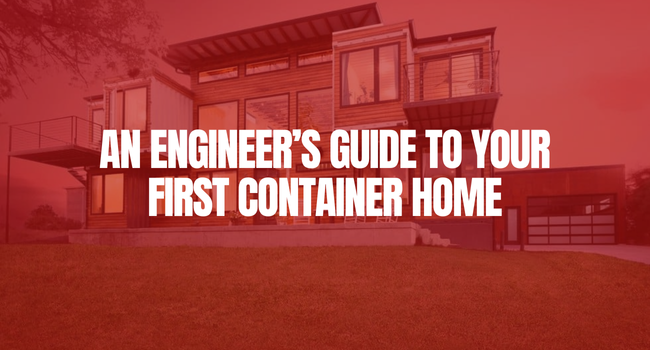
Shipping container homes have become one of the most exciting and cost-effective trends in modern housing. They’re sustainable, versatile, and can be transformed into everything from compact studios to spacious multi-level residences. But while container homes may start with “giant Lego blocks,” building one isn’t as simple as stacking steel boxes. Successful projects require careful planning, structural expertise, and compliance with local codes.
At Ceed Civil Engineering, we’ve helped hundreds of clients design safe, efficient, and beautiful container homes. If you’re considering your first build, here’s what you need to know to get started—from an engineer’s perspective.
1. Define Your Goals and Budget Early
Every container home begins with a vision. Are you looking for a minimalist weekend cabin, a multi-container family home, or a durable ADU (accessory dwelling unit) to expand living space? Your end goal will determine everything from container size and configuration to foundation type.
Budget is equally critical. Container homes can save 30–40% compared to wood-frame construction, and even more when compared to ICF builds, but costs vary depending on design complexity, site preparation, and finish materials. Setting realistic financial expectations early will help you avoid delays and mid-project compromises.
2. Understand Local Codes and Zoning Regulations
One of the first—and most important—steps is confirming whether container homes are permitted in your area. Building codes, zoning restrictions, and homeowner association (HOA) rules can vary widely between regions.
As engineers, we ensure your design complies with local structural, safety, and fire regulations. For example, containers are designed for cargo, not as habitable structures, which means modifications such as wall openings, insulation, and roof loads must be carefully engineered to meet code. Starting with a code-compliant plan saves both time and costly revisions later.
3. Choose the Right Containers
Not all shipping containers are created equal. Standard sizes include 10ft, 20ft, and 40ft, with a 40ft container offering about 320 square feet of floor space. Some clients combine multiple containers for multi-story layouts, while others prefer smaller units for micro-homes.
When sourcing containers, you’ll want to decide between “one-trip” containers (lightly used, better condition) and “retired” containers (more affordable but may show wear and rust). From an engineering perspective, structural integrity is non-negotiable—containers with significant damage or corrosion may not be suitable for residential use.
4. Plan for Foundations and Site Prep
Even though containers are built with reinforced steel, they still require a foundation. Options include concrete slabs, pier foundations, or even specialized footing systems, depending on soil conditions and site slope.
At Ceed Civil, we conduct structural calculations to ensure the foundation safely supports your container home. Site prep may also include grading, utility hookups, drainage planning, and accessibility. These “behind the scenes” elements are critical for long-term durability and functionality.
5. Factor in Modifications and Structural Reinforcement
Transforming a steel container into a livable space requires modifications such as windows, doors, interior walls, and insulation. However, every cut into the steel can weaken the container’s structural integrity. That’s where engineering expertise is essential.
For example, if you’re planning large window openings or stacking multiple containers, reinforcement with steel framing may be required. Roof design also plays a major role—while flat roofs are simple and economical, pitched or living roofs may be more suitable in areas with heavy rain or snow. Our team designs these modifications to ensure your home is both safe and structurally sound.
6. Think Beyond the Box: Design and Lifestyle
One of the most exciting aspects of container homes is their design flexibility. Some clients prefer sleek, modern aesthetics with exposed steel walls, while others integrate traditional finishes to blend into neighborhood settings. Multi-container layouts can create open living spaces, roof decks, or even multi-level homes.
From an engineer’s perspective, we encourage clients to think about functionality in addition to style. For example:
- Insulation & Energy Efficiency: Proper insulation is critical to prevent condensation and maintain comfort.
- Utility Integration: Plan early for plumbing, electrical, and HVAC systems.
- Future Expansion: Many container homes can be designed with modular growth in mind.
7. Partner with Experienced Engineers and Builders
Perhaps the most important advice: don’t go it alone. While container homes are appealing for their affordability and DIY potential, structural safety should never be compromised. Partnering with an experienced engineering firm like Ceed Civil ensures your project is not only creative and cost-efficient, but also code-compliant and built to last.
We specialize in creating detailed plan sets that guide builders through every step—from site preparation to final assembly. Whether you’re designing a compact ADU, a custom residence, or even a specialized structure like a fire-proof home or FEMA housing, we provide the expertise to bring your vision to life.
Final Thoughts
Building your first container home is an exciting opportunity to create a unique, sustainable, and cost-effective living space. But like any construction project, success depends on preparation. From defining your goals and navigating codes to ensuring structural integrity, the right engineering partner can make all the difference.
At Ceed Civil Engineering, we combine innovative design with practical expertise to help clients transform shipping containers into beautiful, functional homes. If you’re ready to start your container home journey, our team is here to guide you every step of the way.
